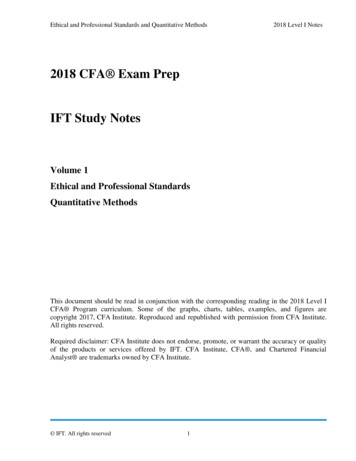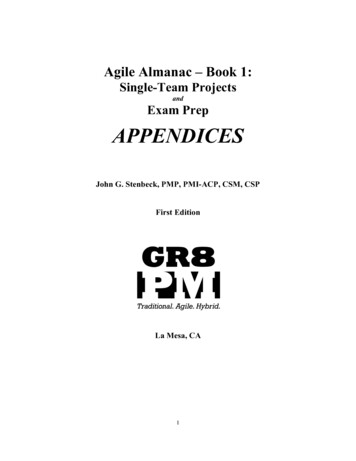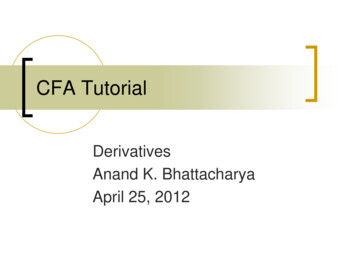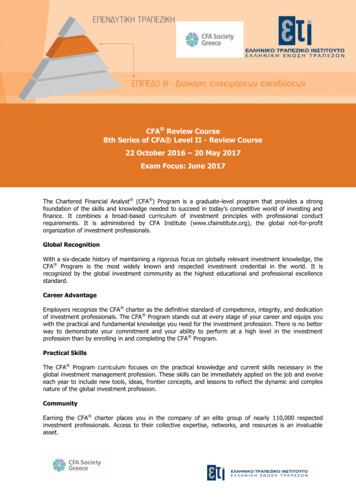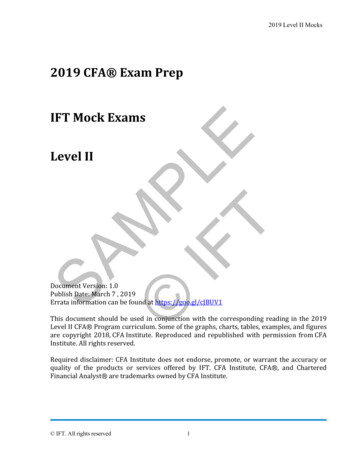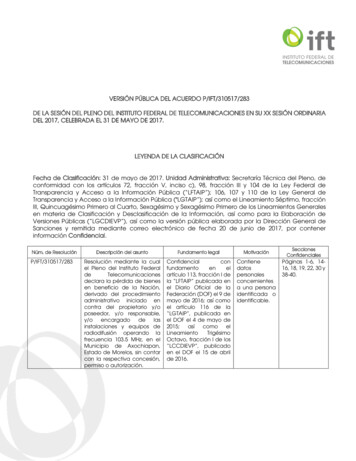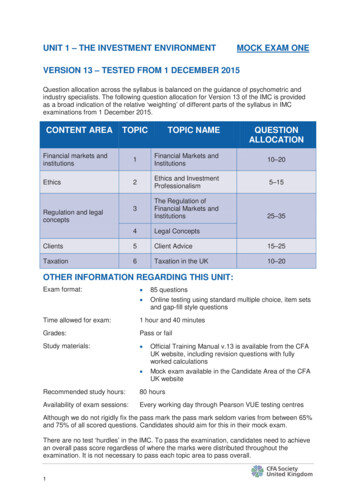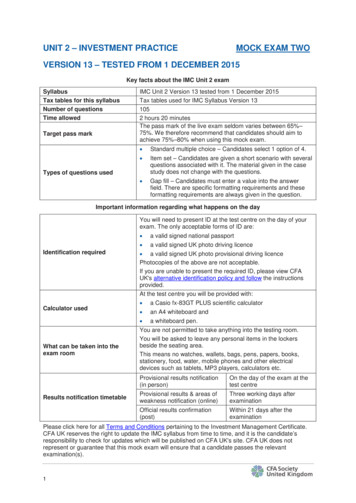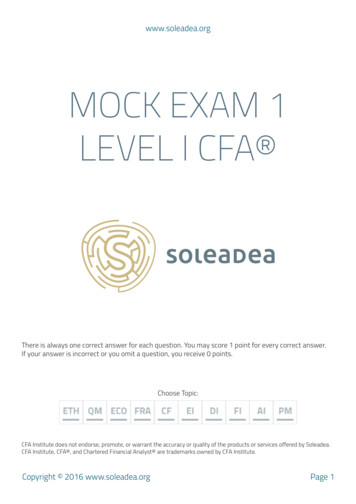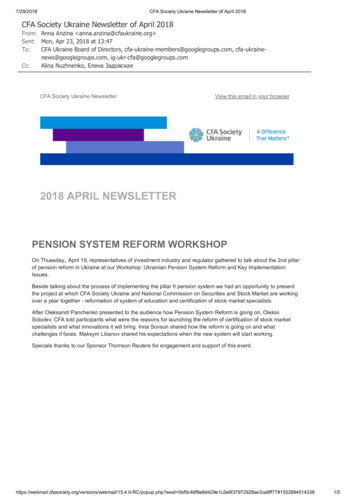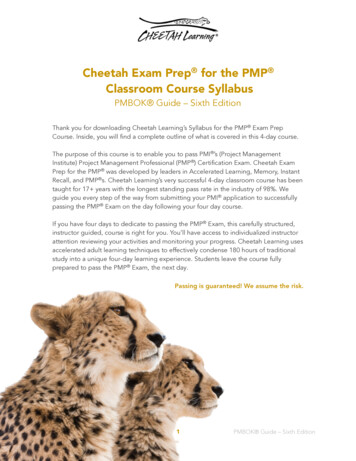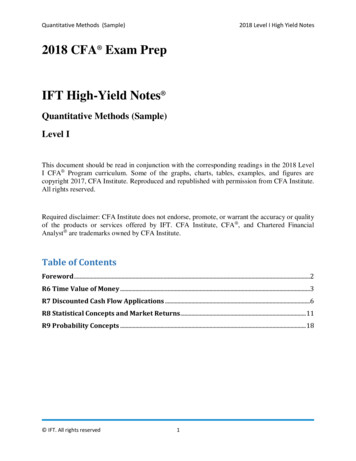
Transcription
Quantitative Methods (Sample)2018 Level I High Yield Notes2018 CFA Exam PrepIFT High-Yield Notes Quantitative Methods (Sample)Level IThis document should be read in conjunction with the corresponding readings in the 2018 LevelI CFA Program curriculum. Some of the graphs, charts, tables, examples, and figures arecopyright 2017, CFA Institute. Reproduced and republished with permission from CFA Institute.All rights reserved.Required disclaimer: CFA Institute does not endorse, promote, or warrant the accuracy or qualityof the products or services offered by IFT. CFA Institute, CFA , and Chartered FinancialAnalyst are trademarks owned by CFA Institute.Table of ContentsForeword .2R6 Time Value of Money .3R7 Discounted Cash Flow Applications .6R8 Statistical Concepts and Market Returns. 11R9 Probability Concepts . 18 IFT. All rights reserved1
Quantitative Methods (Sample)2018 Level I High Yield NotesForewordThe IFT High-Yield Course is based on Pareto’s 80-20 rule according to which 80% of theexam questions are likely to be based on 20% of the curriculum. Hence this course focuseson the 20% material which is most testable.We call this the “High-Yield Course” because your investment (time and money) is low butthe potential return (passing the exam) is high! As with high-yield investments in theworld of finance, there is risk. Your exam will contain some questions which are notaddressed in the High-Yield Course. However, we believe that such questions will be fewand if you complement the High-Yield course with sufficient practice, the probability ofpassing the exam is high.The IFT High-Yield course has three components: notes, lectures and questions.1. IFT High-Yield Notes summarize the most important concepts from each readingin 2 to 5 pages. Key formulas and facts are presented in blue boxes while examplesappear in gray boxes.2. IFT High-Yield Lectures are online video lectures based on the notes. Eachreading is covered in 10 to 20 minutes.3. High-Yield Q-Bank has between 600 and 700 questions covering concepts whichare most likely to show up on the exam.The High-Yield Course can be used on a ‘stand-alone’ basis if you are time-constrained.However, if you do have time, we recommend taking the High-Yield Course along with IFT’sregular material. This will help ensure sufficient mastery of the entire curriculum.Many candidates complain that they forget material covered earlier. The High-Yield Courseaddresses this problem by helping you to quickly revise key concepts.Thank you for trusting IFT to help you with your exam preparation. IFT. All rights reserved2
Quantitative Methods (Sample)2018 Level I High Yield NotesR6 Time Value of MoneyInterpretation of interest ratesInterest rates can be interpreted as: Required rate of return: If you invest 100 today on the condition that you get 110 after a year, then your required rate of return is 10%. Discount rate: For the same example, if you discount the future cash flow of 110using a discount rate of 10%, you get a present value of 100. Opportunity cost: If you spend the 100 today instead of investing, then you losethe opportunity of earning 10% interest. In this sense interest rates can also bethought of as opportunity costs.Components of interest ratesInterest rates have the following components: Real risk-free rate: Return on an investment with zero risk, assuming no inflation. Inflation premium: Extra return required to compensate for inflation. Default risk premium: Extra return required to compensate for the risk that theborrower will not make the promised payments. Liquidity premium: Extra return required to compensate for the risk of receivingless than the fair value of an investment if it must be sold quickly for cash. Maturity premium: The prices for longer-term bonds are more volatile thanshorter-term bonds i.e. they have more maturity risk. Extra return required tocompensate for maturity risk is called maturity premium.Interest rate real risk-free rate inflation premium default risk premium liquiditypremium maturity premium.Nominal interest rate real risk-free rate inflation premiumIn a country ABC, the real risk-free rate is 4% and the expected inflation is 3%. Company Xdomiciled in this country issues a 5-year bond with an estimated default risk premium of2%, liquidity premium of 1% and maturity premium of 1%. Calculate the interest rate ofthis bond.Solution:The interest rate for this bond will be 4 3 2 1 1 11%.Effective annual rateThe stated annual rate is a quoted interest rate that does not consider the effect ofcompounding. The effective annual rate (EAR) is the rate at which money invested willgrow in a year when we do consider compounding.The EAR when there are m compounding periods in a year is: IFT. All rights reserved3
Quantitative Methods (Sample)Effective annual rate (1 2018 Level I High Yield Notesstated annual rate m) 1mThe EAR for continuous compounding is:Effective annual rate estated annual rate 1Calculate the EAR for:1. A stated annual rate of 12% and semiannual compounding.2. A stated annual rate of 12% and quarterly compounding.3. A stated annual rate of 12% and monthly compounding.4. A stated annual rate of 12% and continuous compounding.Solution:1. EAR 1.062 – 1 12.36%2. EAR 1.034 – 1 12.55%3. EAR 1.0112 –1 12.68%4. EAR e0.12 –1 12.75%Note that for the same stated annual rate, the EAR increases as the frequency ofcompounding increases.Non-annual compounding frequenciesStep 1: Divide the stated annual interest rate by the number of compounding periods peryear (m).Step 2: Multiply the number of years by the number of compounding periods per year (m).Step 3: Use the following formula to calculate future value.Future value present value (1 stated interest rate mN)mYou invest 10,000 in a 5-year bond. The bond offers a stated annual interest rate of 12%compounded semi-annually. What will be the value of the investment at the end of fiveyears?Solution:Step 1: 12 / 2 6%Step 2: 5 x 2 10 periodsStep 3: FV 10,000 (1.06)10 17,908.47Calculating PV and FV of different cash flowsPresent value is the current value of a future cash flow. Longer the time period till the future amount is received, lower the present value. Higher the discount rate, lower the present value.Future value is the value to which an investment will grow after one or morecompounding periods. IFT. All rights reserved4
Quantitative Methods (Sample) 2018 Level I High Yield NotesLonger the time period till which the investment is allowed to grow, higher thefuture value.Higher the interest rate, the higher the future value.The future value and the present value of a single sum of money can be calculated by usingthe formulae given below or by using the TVM keys on a financial calculator (recommendedapproach for the exams).FV PV (1 I/Y)NPV FV / (1 I/Y)NYou invest 100 today at an interest rate of 10% for 5 years. How much will you receiveafter five years?Solution:Plug the following values in the calculator.N 5; I/Y 10; PV 100, PMT 0; CPT FV 161.05An ordinary annuity is series of finite but equal cash flows which occur at the end of eachperiod.How much should you invest today at an interest rate of 10% to receive 100 at the end ofeach year for 5 years?Using the calculator: N 5; I/Y 10; PMT 100; FV 0; CPT PV 379.08An annuity due is a series of finite but equal cash flows which occur at the start of eachperiod.How much should you invest today at an interest rate of 10% to receive 100 at thebeginning of each year for 5 years?Solution:Put the calculator in BGN mode and plug the following values. (Remember to exit the BGNmode once you are done with your calculations.)N 5; I/Y 10; PMT 100, FV 0; CPT PV 416.98A perpetuity is a series of equal cash flows at regular intervals occurring forever. Thepresent value of perpetuity can be calculated as:PV of a perpetuity PMTI/YHow much should you invest today at an interest rate of 10% to receive 100 at the end ofeach year forever?Solution:PV 100/0.1 1,000The present (future) value of any series of cash flows is equal to the sum of the present(future) values of the individual cash flows. IFT. All rights reserved5
Quantitative Methods (Sample)2018 Level I High Yield NotesWhat is the future value of the following series of cash flows, given an interest rate of 10%? 1,000 at the end of year 1, 2,000 at the end of year 2, 3,000 at the end of year 3, 4,000at the end of year 4 and 5,000 at the end of year 5.Solution:The future value is 5000 4000 x 1.1 3000 x 1.12 2000 x 1.13 1000 x 1.14 17,156Using time linesA time-line is a diagram that shows the inflow and outflow of money at various timeperiods. Constructing a time-line will help you solve time value of money problems.Consider the following simple example.Suppose you will receive 100 at the end of Year 3, Year 4 and Year 5. What is the PV attime 0 given a discount rate of 5%?Time:0123455% Cash flows:PV ? 0 0 100 100 100Solution:To solve this problem you can draw the above time-line, depicting the cash flows. The threepayments of 100 can be treated as an ordinary annuity and we can calculate its PV at theend of year 2.Plug the following values in the calculator:N 3; I/Y 5; PMT 100, FV 0; CPT PV 272.32The time line now simplifies to:Time:01235% Cash flows:PV ?0 272.32 0To discount to time 0, plug the following values in the calculator:N 2; I/Y 5; PMT 0; FV 272.32; CPT PV 247.45 0 0R7 Discounted Cash Flow ApplicationsNet present value (NPV) & Internal rate of return (IRR)The NPV of an investment is the present value of its cash inflows minus the present valueof its cash outflows. The NPV of a project is calculated as:CF1CF2CF3NPV CF0 [(1 r)1] [(1 r)2 ] [(1 r)3]Consider a project which requires an initial investment of 10,000. It is expected togenerate 5,000 in the first year, 6,000 in the second year and 7,000 in the third year. IFT. All rights reserved6
Quantitative Methods (Sample)2018 Level I High Yield NotesThe cost of capital for this project is 10%. Calculate the NPV of this project.Solution:5,0006,0007,000NPV 10,000 (1.1)1 (1.1)2 (1.1)3NPV 4,763.33Using the financial calculator: CF0 -10,000; CF1 5,000; CF2 6,000; CF3 7,000; I 10.CPT NPV 4,763.33The IRR is the discount rate the makes the NPV equal to zero. i.e. it equates the PV of thecash inflows to the PV of the cash outflows. The IRR of a project is calculated as:CF1CF2CF3CF0 [(1 IRR)1 ] [(1 IRR)2 ] [(1 IRR)3 ]Consider a project which requires an initial investment of 10,000. It is expected togenerate 5,000 in the first year, 6,000 in the second year and 7,000 in the third year.Calculate the IRR of this project.Solution:5,0006,0007,00010,000 [(1 IRR)1 ] [(1 IRR)2 ] [(1 IRR)3 ]IRR 33.87%Using the financial calculator: CF0 -10,000; CF1 5,000; CF2 6,000; CF3 7,000; I 10;CPT IRR 33.87Conflict between NPV & IRRNPV Rule For independent projects, accept a project if NPV 0. For mutually exclusive projects, select the project with the highest positive NPV.An independent project is one where the decision to accept or reject the project has noeffect on any other projects being considered by the company. Hence, if a company isevaluating two independent projects, it can invest in both projects.A mutually exclusive project is one where the acceptance of such a project will have aneffect on the acceptance of another project. Hence, if a company is evaluating two mutuallyexclusive projects, then it can invest in only one of the projects.IRR Rule For independent projects, accept if IRR required rate of return. For mutually exclusive projects, select the project with the highest IRR.Problems associated with IRR IRR wrongly assumes that the interim cash flows are reinvested at the IRR rate andnot at the cost of capital. A project may have multiple IRRs or no IRR. IFT. All rights reserved7
Quantitative Methods (Sample) 2018 Level I High Yield NotesFor mutually exclusive projects, due to differences in project size or timing of cashflows, the IRR and NPV rankings may differ. If there is a conflict in ranking, go withthe NPV rule.Holding period returnThe holding period return is the total return for holding an investment over a given timeperiod. It is calculated as:HPR P1 P0 D1P0where:P0 price at the start of the holding periodP1 price at the end of the holding periodD1 dividend/coupon paid by the investment at the end of the holding periodAn investor bought a stock for 100. Five months later, he received a dividend of 4 and hesold the stock for 108. Compute the HPR.Solution:HPR 108 – 100 4100 0.12 12%Money-weighted & Time weighted rate of returnMoney-weighted rate of return The money-weighted rate of return is simply the IRR of a portfolio taking intoaccount all cash inflows and outflows. If a manager controls the cash inflows and outflows of a portfolio, then use moneyweighted return to measure performance.An investor buys a stock for 10 at time t 0. At the end of Year 1, he receives a dividend of 1 and purchases another stock for 12. At the end of Year 2, he receives a dividend of 0.5per share and sells both shares for 13. Calculate the money-weighted return.Sol
Step 1: Divide the stated annual interest rate by the number of compounding periods per year ( m ). Step 2: Multiply the number of years by the number of compounding periods per year ( m ).
